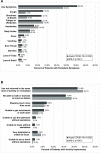Risk factors for health impairments in children after hospitalization for acute COVID-19 or MIS-C
- PMID: 37920792
- PMCID: PMC10619659
- DOI: 10.3389/fped.2023.1260372
Risk factors for health impairments in children after hospitalization for acute COVID-19 or MIS-C
Abstract
Objective: To identify risk factors for persistent impairments after pediatric hospitalization for acute coronavirus disease 2019 (COVID-19) or multisystem inflammatory syndrome in children (MIS-C) during the SARS-CoV-2 pandemic.
Methods: Across 25 U.S. Overcoming COVID-19 Network hospitals, we conducted a prospective cohort study of patients <21-years-old hospitalized for acute COVID-19 or MIS-C (May 2020 to March 2022) surveyed 2- to 4-months post-admission. Multivariable regression was used to calculate adjusted risk ratios (aRR) and 95% confidence intervals (CI).
Results: Of 232 children with acute COVID-19, 71 (30.6%) had persistent symptoms and 50 (21.6%) had activity impairments at follow-up; for MIS-C (n = 241), 56 (23.2%) had persistent symptoms and 58 (24.1%) had activity impairments. In adjusted analyses of patients with acute COVID-19, receipt of mechanical ventilation was associated with persistent symptoms [aRR 1.83 (95% CI: 1.07, 3.13)] whereas obesity [aRR 2.18 (95% CI: 1.05, 4.51)] and greater organ system involvement [aRR 1.35 (95% CI: 1.13, 1.61)] were associated with activity impairment. For patients with MIS-C, having a pre-existing respiratory condition was associated with persistent symptoms [aRR 3.04 (95% CI: 1.70, 5.41)] whereas obesity [aRR 1.86 (95% CI: 1.09, 3.15)] and greater organ system involvement [aRR 1.26 (1.00, 1.58)] were associated with activity impairments.
Discussion: Among patients hospitalized, nearly one in three hospitalized with acute COVID-19 and one in four hospitalized with MIS-C had persistent impairments for ≥2 months post-hospitalization. Persistent impairments were associated with more severe illness and underlying health conditions, identifying populations to target for follow-up.
Keywords: COVID-19; COVID-19 post-intensive care syndrome; MIS-C; SARS-CoV-2; critical care outcomes; multisystem inflammatory syndrome in children; pediatrics; post-acute COVID-19 syndrome.
© 2023 Maddux, Young, Kucukak, Zambrano, Newhams, Rollins, Halasa, Gertz, Mack, Schwartz, Kong, Loftis, Irby, Rowan, Tarquinio, Zinter, Crandall, Cvijanovich, Schuster, Fitzgerald, Staat, Hobbs, Nofziger, Shein, Flori, Cullimore, Chatani, Levy, Typpo, Hume, Campbell, Randolph and the Overcoming COVID-19 Investigators.
Conflict of interest statement
The authors declare that the research was conducted in the absence of any commercial or financial relationships that could be construed as a potential conflict of interest. The author(s) declared that they were an editorial board member of Frontiers, at the time of submission. This had no impact on the peer review process and the final decision.
Figures




References
-
- Centers for Disease Control and Prevention. Demographic trends of COVID-19 cases and deaths in the US reported to CDC. Available at: https://covid.cdc.gov/covid-data-tracker/#demographics
-
- Centers for Disease Control and Prevention. COVID data tracker 2023. Available at: https://covid.cdc.gov/covid-data-tracker/#new-hospital-admissions
-
- World Health Organization. WHO coronavirus (COVID-19) dashboard 2023. Available at: https://covid19.who.int/
-
- Health Department-Reported cases of multisystem inflammatory syndrome in children (MIS-C) in the United States: Centers for Disease Control and Prevention (2023). Available at: https://covid.cdc.gov/covid-data-tracker/#mis-national-surveillance (Updated January 30, 2023).
Grants and funding
LinkOut - more resources
Full Text Sources
Miscellaneous

